剑桥10阅读解析Test3
- 格式:doc
- 大小:209.50 KB
- 文档页数:12
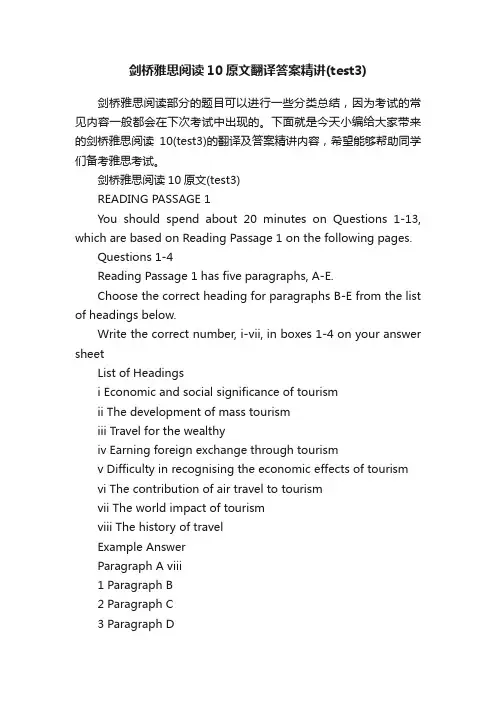
剑桥雅思阅读10原文翻译答案精讲(test3)剑桥雅思阅读部分的题目可以进行一些分类总结,因为考试的常见内容一般都会在下次考试中出现的。
下面就是今天小编给大家带来的剑桥雅思阅读10(test3)的翻译及答案精讲内容,希望能够帮助同学们备考雅思考试。
剑桥雅思阅读10原文(test3)READING PASSAGE 1You should spend about 20 minutes on Questions 1-13, which are based on Reading Passage 1 on the following pages.Questions 1-4Reading Passage 1 has five paragraphs, A-E.Choose the correct heading for paragraphs B-E from the list of headings below.Write the correct number, i-vii, in boxes 1-4 on your answer sheetList of Headingsi Economic and social significance of tourismii The development of mass tourismiii Travel for the wealthyiv Earning foreign exchange through tourismv Difficulty in recognising the economic effects of tourismvi The contribution of air travel to tourismvii The world impact of tourismviii The history of travelExample AnswerParagraph A viii1 Paragraph B2 Paragraph C3 Paragraph D4 Paragraph EThe Context, Meaning and Scope of TourismA Travel has existed since the beginning of time, when primitive man set out, often traversing great distances in search of game, which provided the food and clothing necessary for his survival. Throughout the course of history, people have travelled for purposes of trade, religious conviction, economic gain, war, migration and other equally compelling motivations. In the Roman era, wealthy aristocrats and high government officials also travelled for pleasure. Seaside resorts located at Pompeii and Herculaneum afforded citizens the opportunity to escape to their vacation villas in order to avoid the summer heat of Rome. Travel, except during the Dark Ages, has continued to grow and, throughout recorded history, has played a vital role in the development of civilisations and their economies.B Tourism in the mass form as we know it today is a distinctly twentieth-century phenomenon. Historians suggest that the advent of mass tourism began in England during the industrial revolution with the rise of the middle class and the availability of relatively inexpensive transportation. The creation of the commercial airline industry following the Second World War and the subsequent development of the jet aircraft in the 1950s signalled the rapid growth and expansion of international travel. This growth led to the development of a major new industry: tourism. In turn, international tourism became the concern of a number of world governments since it not only provided new employment opportunities but also produced a means of earning foreign exchange.C Tourism today has grown significantly in both economic and social importance. In most industrialised countries over thepast few years the fastest growth has been seen in the area of services. One of the largest segments of the service industry, although largely unrecognised as an entity in some of these countries, is travel and tourism. According to the World Travel and Tourism Council (1992), ‘Travel and tourism is the largest industry in the world on virtually any economic measure including value-added capital investment, employment and tax contributions’. In 1992, the industry’s gross output was estimated to be $3.5 trillion, over 12 per cent of all consumer spending. The travel and tourism industry is the world’s largest employer with almost 130 million jobs, or almost 7 per cent of all employees. This industry is the world’s leading industrial contributor, producing over 6 per cent of the world’s national product and accounting for capital investment in excess of $422 billion in direct, indirect and personal taxes each year. Thus, tourism has a profound impact both on the world economy and, because of the educative effect of travel and the effects on employment, on society itself.D However, the major problems of the travel and tourism industry that have hidden, or obscured, its economic impact are the diversity and fragmentation of the industry itself. The travel industry includes: hotels, motels and other types of accommodation; restaurants and other food services; transportation services and facilities; amusements, attractions and other leisure facilities; gift shops and a large number of other enterprises. Since many of these businesses also serve local residents, the impact of spending by visitors can easily be overlooked or underestimated. In addition, Meis (1992) points out that the tourism industry involves concepts that have remained amorphous to both analysts and decision makers.Moreover, in all nations this problem has made it difficult for the industry to develop any type of reliable or credible tourism information base in order to estimate the contribution it makes to regional, national and global economies. However, the nature of this very diversity makes travel and tourism ideal vehicles for economic development in a wide variety of countries, regions or communities.E Once the exclusive province of the wealthy, travel and tourism have become an institutionalised way of life for most of the population. In fact, McIntosh and Goeldner (1990) suggest that tourism has become the largest commodity in international trade for many nations and, for a significant number of other countries, it ranks second or third. For example, tourism is the major source of income in Bermuda, Greece, Italy, Spain, Switzerland and most Caribbean countries. In addition, Hawkins and Ritchie, quoting from data published by the American Express Company, suggest that the travel and tourism industry is the number one ranked employer in the Bahamas, Brazil, Canada, France, (the former) West Germany, Hong Kong, Italy, Jamaica, Japan, Singapore, the United Kingdom and the United States. However, because of problems of definition, which directly affect statistical measurement, it is not possible with any degree of certainty to provide precise, valid or reliable data about the extent of world-wide tourism participation or its economic impact. In many cases, similar difficulties arise when attempts are made to measure domestic tourism.Questions 5-10Do the following statements agree with the information given in Reading Passage 1?In boxes 5-10 on your answer sheet, writeTRUE if the statement agrees with the informationFALSE if the statement contradicts the informationNOT GIVEN if there is no information on this5 The largest employment figures in the world are found in the travel and tourism industry.6 Tourism contributes over six per cent of the Australian gross national product.7 Tourism has a social impact because it promotes recreation.8 Two main features of the travel and tourism industry make its economic significance difficult to ascertain.9 Visitor spending is always greater than the spending of residents in tourist areas.10 It is easy to show statistically how tourism affects individual economies.Questions 11-13Complete the sentences below.Choose NO MORE THAN THREE WORDS from the passage for each answer.Write your answers in boxes 11-13 on your answer sheet.11 In Greece, tourism is the most important .12 The travel and tourism industry in Jamaica is the major .13 The problems associated with measuring international tourism are often reflected in the measurement of .READING PASSAGE 2You should spend about 20 minutes on Questions 14-26, which are based on Reading Passage 2 below.Autumn leavesCanadian writer Jay Ingram investigates the mystery of why leaves turn red in the fallA One of the most captivating natural events of the year inmany areas throughout North America is the turning of the leaves in the fall. The colours are magnificent, but the question of exactly why some trees turn yellow or orange, and others red or purple, is something which has long puzzled scientists.B Summer leaves are green because they are full of chlorophyll, the molecule that captures sunlight and converts that energy into new building materials for the tree. As fall approaches in the northern hemisphere, the amount of solar energy available declines considerably. For many trees —evergreen conifers being an exception — the best strategy is to abandon photosynthesis_until the spring. So rather than maintaining the now redundant leaves throughout the winter, the tree saves its precious resources and discards them. But before letting its leaves go, the tree dismantles their chlorophyll molecules and ships their valuable nitrogen back into the twigs. As chlorophyll is depleted, other colours that have been dominated by it throughout the summer begin to be revealed. This unmasking explains the autumn colours of yellow and orange, but not the brilliant reds and purples of trees such as the maple or sumac.C The source of the red is widely known: it is created by anthocyanins, water-soluble plant pigments reflecting the red to blue range of the visible spectrum. They belong to a class of sugar-based chemical compounds also known as flavonoids. What’s puzzling is tha t anthocyanins are actually newly minted, made in the leaves at the same time as the tree is preparing to drop them. But it is hard to make sense of the manufacture of anthocyanins — why should a tree bother making new chemicals in its leaves when it’s alr eady scrambling to withdraw and preserve the ones already there?D Some theories about anthocyanins have argued that they might act as a chemical defence against attacks by insects or fungi, or that they might attract fruit-eating birds or increase a leaf’s tolerance to freezing. However there are problems with each of these theories, including the fact that leaves are red for such a relatively short period that the expense of energy needed to manufacture the anthocyanins would outweigh any anti-fungal or anti-herbivore activity achieved._photosynthesis: the production of new material from sunlight, water and carbon dioxideE It has also been proposed that trees may produce vivid red colours to convince herbivorous insects that they are healthy and robust and would be easily able to mount chemical defences against infestation. If insects paid attention to such advertisements, they might be prompted to lay their eggs on a duller, and presumably less resistant host. The flaw in this theory lies in the lack of proof to support it. No one has as yet ascertained whether more robust trees sport the brightest leaves, or whether insects make choices according to colour intensity.F Perhaps the most plausible suggestion as to why leaves would go to the trouble of maki ng anthocyanins when they’re busy packing up for the winter is the theory known as the ‘light screen’ hypothesis. It sounds paradoxical, because the idea behind this hypothesis is that the red pigment is made in autumn leaves to protect chlorophyll, the light-absorbing chemical, from too much light. Why does chlorophyll need protection when it is the natural world’s supreme light absorber? Why protect chlorophyll at a time when the tree is breaking it down to salvage as much of it as possible?G Chlorophyll, although exquisitely evolved to capture theenergy of sunlight, can sometimes be overwhelmed by it, especially in situations of drought, low temperatures, or nutrient deficiency. Moreover, the problem of oversensitivity to light is even more acute in the fall, when the leaf is busy preparing for winter by dismantling its internal machinery. The energy absorbed by the chlorophyll molecules of the unstable autumn leaf is not immediately channelled into useful products and processes, as it would be in an intact summer leaf. The weakened fall leaf then becomes vulnerable to the highly destructive effects of the oxygen created by the excited chlorophyll molecules.H Even if you had never suspected that this is what was going on when leaves turn red, there are clues out there. One is straightforward: on many trees, the leaves that are the reddest are those on the side of the tree which gets most sun. Not only that, but the red is brighter on the upper side of the leaf. It has also been recognised for decades that the best conditions for intense red colours are dry, sunny days and cool nights, conditions that nicely match those that make leaves susceptible to excess light. And finally, trees such as maples usually get much redder the more north you travel in the northern hemisphere. It’s colder there, they’re more stressed, their chlorophyll is more sensitive and it needs more sunblock.I What is still not fully understood, however, is why some trees resort to producing red pigments while others don’t bother, and simply reveal their orange or yellow hues. Do these trees have other means at their disposal to prevent overexposure to light in autumn? Their story, though not as spectacular to the eye, will surely turn out to be as subtle and as complex.Questions 14-18Reading Passage 2 has nine paragraphs, A-I.Which paragraph contains the following information?Write the correct letter, A-I, in boxes 14-18 on your answer sheet.NB You may use any letter more than once.14 a description of the substance responsible for the red colouration of leaves15 the reason why trees drop their leaves in autumn16 some evidence to confirm a theory about the purpose of the red leaves17 an explanation of the function of chlorophyll18 a suggestion that the red colouration in leaves could serve as a warning signalQuestions 19-22Complete the notes below.Choose ONE WORD ONLY from the passage for each answer.Write your answers in boxes 19-22 on your answer sheet.Why believe the ‘light screen’ hypothesis?The most vividly coloured red leaves are found on the side of the tree facing the 19 .The 20 surfaces of leaves contain the most red pigment.Red leaves are most abundant when daytime weather conditions are 21 and sunny.The intensity of the red colour of leaves increases as you go further 22 .Questions 23-25Do the following statements agree with the information given in Reading Passage 2?In boxes 23-25 on your answer sheet, writeTRUE if the statement agrees with the informationFALSE if the statement contradicts the informationNOT GIVEN if there is no information on this23 It is likely that the red pigments help to protect the leaf from freezing temperatures.24 The ‘light screen’ hypothesis would initially seem to contradict what is known about chlorophyll.25 Leaves which turn colours other than red are more likely to be damaged by sunlight.Question 26Choose the correct letter A, B, C or D.Write the correct letter in box 26 on your answer sheet.For which of the following questions does the writer offer an explanation?A why conifers remain green in winterB how leaves turn orange and yellow in autumnC how herbivorous insects choose which trees to lay their eggs inD why anthocyanins are restricted to certain treesREADING PASSAGE 3You should spend about 20 minutes on Questions 27-40, which are based on Reading Passage 3 below.Beyond the blue horizonAncient voyagers who settled the far-flung islands of the Pacific OceanAn important archaeological discovery on the island of Efate in the Pacific archipelago of Vanuatu has revealed traces of an ancient seafaring people, the distant ancestors of today’s Polynesians. The site came to light only by chance. An agricultural worker, digging in the grounds of a derelict plantation, scraped open a grave — the first of dozens in a burial ground some 3,000 years old. It is the oldest cemetery ever found in the Pacificislands, and it harbors the remains of an ancient people archaeologists call the Lapita.They were daring blue-water adventurers who used basic canoes to rove across the ocean. But they were not just explorers. They were also pioneers who carried with them everything they would need to build new lives — their livestock, taro seedlings and stone tools. Within the span of several centuries, the Lapita stretched the boundaries of their world from the jungle-clad volcanoes of Papua New Guinea to the loneliest coral outliers of Tonga.The Lapita left precious few clues about themselves, but Efate expands the volume of data available to researchers dramatically. The remains of 62 individuals have been uncovered so far, and archaeologists were also thrilled to find six complete Lapita pots. Other items included a Lapita burial urn with modeled birds arranged on the rim as though peering down at the human remains sealed inside. ‘It’s an important discovery,’ says Matthew Spriggs, professor of archaeology at the Australian National University and head of the international team digging up the site, ‘for it conclusively identifies the remains as Lapita.’DNA teased from these human remains may help answer one of the most puzzling questions in Pacific anthropology: did all Pacific islanders spring from one source or many? Was there only one outward migration from a single point in Asia, or several from different points? ‘This represents the best opportunity we’ve had yet,’ says Spriggs, ‘to find out who the Lapita actually were, where they came from, and who their closest descendants are today.’There is one stubborn question for which archaeology has yet to provide any answers: how did the Lapita accomplish theancient equivalent of a moon landing, many times over? No-one has found one of their canoes or any rigging, which could reveal how the canoes were sailed. Nor do the oral histories and traditions of later Polynesians offer any insights, for they turn into myths long before they reach as far back in time as the Lapita.‘All we can say for certain is that the Lapita had canoes that were capable of ocean voyages, and they had the ability to sail them,’ says Geoff Irwin, a professor of archaeology at the University of Auckland. Those sailing skills, he says, were developed and passed down over thousands of years by earlier mariners who worked their way through the archipelagoes of the western Pacific, making short crossings to nearby islands. The real adventure didn’t begin, however, until their Lapita descendants sailed out of sight of land, with empty horizons on every side. This must have been as difficult for them as landing on the moon is for us today. Certainly it distinguished them from their ancestors, but what gave them the courage to launch out on such risky voyages?The Lapita’s thrust into the Pacific was eastward, against the prevailing trade winds, Irwin notes. Those nagging headwinds, he argues, may have been the key to their success. ‘They could sail out for days into the unknown and assess the area, secure in the knowledge that if they didn’t find anything, they could turn about and catch a swift ride back on the trade winds. This is what would have made the whole thing work.’ Once out there, skilled seafarers would have detected abundant leads to follow to land: seabirds, coconuts and twigs carried out to sea by the tides, and the afternoon pile-up of clouds on the horizon which often indicates an island in the distance.For returning explorers, successful or not, the geography oftheir own archipelagoes would have provided a safety net. Without this to go by, overshooting their home ports, getting lost and sailing off into eternity would have been all too easy. Vanuatu, for example, stretches more than 500 miles in a northwest-southeast trend, its scores of intervisible islands forming a backstop for mariners riding the trade winds home.All this presupposes one essential detail, says Atholl Anderson, professor of prehistory at the Australian National University: the Lapita had mastered the advanced art of sailing against the wind. ‘And there’s no proof they could do any such thing,’ Anderson says. ‘There has been this assumption they did, and people have built canoes to re-create those early voyages based on that assumption. But nobody has any idea what their canoes looked like or how they were rigged.’Rather than give all the credit to human skill, Anderson invokes the winds of chance. El Nino, the same climate disruption that affects the Pacific today, may have helped scatter the Lapita, Anderson suggests. He points out that climate data obtained from slow-growing corals around the Pacific indicate a series of unusually frequent El Ninos around the time of the Lapita expansion. By reversing the regular east-to-west flow of the trade winds for weeks at a time, these ‘super El Ninos’ might have taken the Lapita on long unplanned voyages.However they did it, the Lapita spread themselves a third of the way across the Pacific, then called it quits for reasons known only to them. Ahead lay the vast emptiness of the central Pacific and perhaps they were too thinly stretched to venture farther. They probably never numbered more than a few thousand in total, and in their rapid migration eastward they encountered hundreds of islands — more than 300 in Fiji alone.Questions 27-31Complete the summary using the list of words and phrases, A-J, below.Write the correct letter, A-J, in boxes 27-31 on your sheet.The Efate burial siteA 3,000-year-old burial ground of a seafaring people called the Lapita has been found on an abandoned 27 on the Pacific island of Efate. The cemetery, which is a significant 28 , was uncovered accidentally by an agricultural worker.The Lapita explored and colonised many Pacific islands over several centuries. They took many things with them on their voyages including 29 and tools.The burial ground increases the amount of information about the Lapita available to scientists. A team of researchers, led by Matthew Spriggs from the Australian National University, are helping with the excavation of the site. Spriggs believes the 30 which was found at the site is very important since it confirms that the 31 found inside are Lapita.A proofB plantationC harbourD bonesE dataF archaeological discoveryG burial urnH sourceI animalsJ mapsQuestions 32-35Choose the correct letter, A. B, C or D.Write the correct letter in boxes 32-35 on your answer sheet.32 According to the writer, there are difficulties explaining how the Lapita accomplished their journeys becauseA the canoes that have been discovered offer relatively few clues.B archaeologists have shown limited interest in this area of research.C little information relating to this period can be relied upon for accuracy.D technological advances have altered the way such achievements are viewed.33 According to the sixth paragraph, what was extraordinary about the Lapita?A They sailed beyond the point where land was visible.B Their cultural heritage discouraged the expression of fear.C They were able to build canoes that withstood ocean voyages.D Their navigational skills were passed on from one generation to the next.34 What does ‘This’ refer to in the seventh parag raph?A the Lapita’s seafaring talentB the Lapita’s ability to detect signs of landC the Lapita’s extensive knowledge of the regionD the Lapita’s belief they would be able to return home35 According to the eighth paragraph, how was the geography of the region significant?A It played an important role in Lapita culture.B It meant there were relatively few storms at sea.C It provided a navigational aid for the Lapita.D It made a large number of islands habitable.Questions 36-40Do the following statements agree with the views of the writer in Reading Passage 3?In boxes 36-40 on your answer sheet, writeYES if the statement agrees with the views of the writerNO if the statement contradicts the views of the writerNOT GIVEN if it is impossible to say what the writer thinks about this36 It is now clear that the Lapita could sail into a prevailing wind.37 Extreme climate conditions may have played a role in Lapita migration.38 The Lapita learnt to predict the duration of El Ninos.39 It remains unclear why the Lapita halted their expansion across the Pacific.40 It is likely that the majority of Lapita settled on Fiji.剑桥雅思阅读10原文参考译文(test3)Passage 1参考译文:旅游的背景,意义和范畴A. 自从上帝创造了万物以来,旅行就已经存在了:那时原始人启程,常常穿越很远的距离搜寻猎物,这些猎物提供了生存所必需的食物以及衣物。
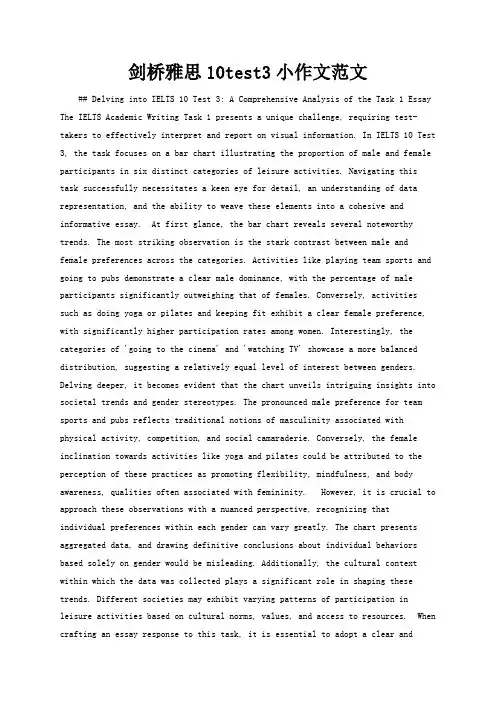
剑桥雅思10test3小作文范文## Delving into IELTS 10 Test 3: A Comprehensive Analysis of the Task 1 Essay The IELTS Academic Writing Task 1 presents a unique challenge, requiring test-takers to effectively interpret and report on visual information. In IELTS 10 Test 3, the task focuses on a bar chart illustrating the proportion of male and female participants in six distinct categories of leisure activities. Navigating thistask successfully necessitates a keen eye for detail, an understanding of data representation, and the ability to weave these elements into a cohesive and informative essay. At first glance, the bar chart reveals several noteworthy trends. The most striking observation is the stark contrast between male andfemale preferences across the categories. Activities like playing team sports and going to pubs demonstrate a clear male dominance, with the percentage of male participants significantly outweighing that of females. Conversely, activitiessuch as doing yoga or pilates and keeping fit exhibit a clear female preference, with significantly higher participation rates among women. Interestingly, the categories of 'going to the cinema' and 'watching TV' showcase a more balanced distribution, suggesting a relatively equal level of interest between genders. Delving deeper, it becomes evident that the chart unveils intriguing insights into societal trends and gender stereotypes. The pronounced male preference for team sports and pubs reflects traditional notions of masculinity associated with physical activity, competition, and social camaraderie. Conversely, the female inclination towards activities like yoga and pilates could be attributed to the perception of these practices as promoting flexibility, mindfulness, and body awareness, qualities often associated with femininity. However, it is crucial to approach these observations with a nuanced perspective, recognizing thatindividual preferences within each gender can vary greatly. The chart presents aggregated data, and drawing definitive conclusions about individual behaviors based solely on gender would be misleading. Additionally, the cultural context within which the data was collected plays a significant role in shaping these trends. Different societies may exhibit varying patterns of participation inleisure activities based on cultural norms, values, and access to resources. When crafting an essay response to this task, it is essential to adopt a clear andorganized structure. A well-structured essay typically begins with an introductory paragraph that paraphrases the task and outlines the key trends observed in the bar chart. Subsequent paragraphs should delve deeper into specific details, highlighting the most significant differences and similarities between male and female participation rates across the various categories. It is crucial to support these observations with concrete data from the chart, using accurate figures and percentages to enhance the credibility of the analysis. Furthermore, employing a range of vocabulary and grammatical structures can elevate the quality of the writing. For instance, using comparative and superlative adjectives like 'higher,' 'lower,' 'most popular,' and 'least popular' allows for clear comparisons between different data points. Additionally, incorporating transition words such as'however,' 'furthermore,' and 'in contrast' facilitates smooth transitions between ideas and ensures a logical flow within the essay. In conclusion, successfully tackling the IELTS 10 Test 3 Task 1 essay requires a comprehensive understanding of the data presented, a critical analysis of gender trends and societal influences, and the ability to communicate these insights effectively through a well-structured and engaging piece of writing. By observing these key elements, test-takers can confidently approach this task and demonstrate their proficiency in interpreting and reporting on visual information.。
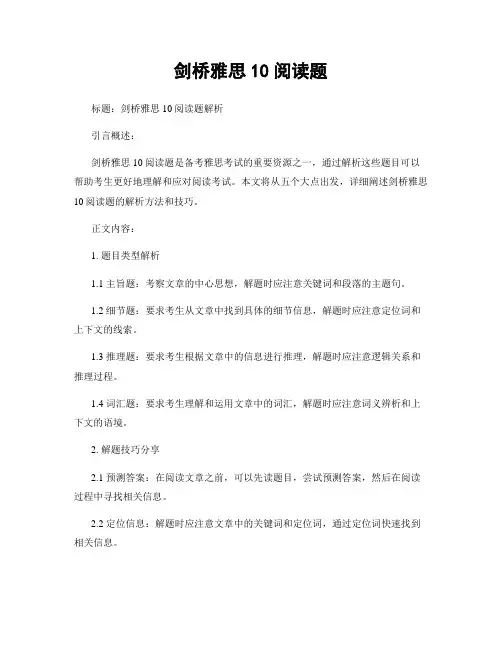
剑桥雅思10阅读题标题:剑桥雅思10阅读题解析引言概述:剑桥雅思10阅读题是备考雅思考试的重要资源之一,通过解析这些题目可以帮助考生更好地理解和应对阅读考试。
本文将从五个大点出发,详细阐述剑桥雅思10阅读题的解析方法和技巧。
正文内容:1. 题目类型解析1.1 主旨题:考察文章的中心思想,解题时应注意关键词和段落的主题句。
1.2 细节题:要求考生从文章中找到具体的细节信息,解题时应注意定位词和上下文的线索。
1.3 推理题:要求考生根据文章中的信息进行推理,解题时应注意逻辑关系和推理过程。
1.4 词汇题:要求考生理解和运用文章中的词汇,解题时应注意词义辨析和上下文的语境。
2. 解题技巧分享2.1 预测答案:在阅读文章之前,可以先读题目,尝试预测答案,然后在阅读过程中寻找相关信息。
2.2 定位信息:解题时应注意文章中的关键词和定位词,通过定位词快速找到相关信息。
2.3 理解作者观点:在解答主旨题和推理题时,要理解作者的观点和态度,通过推理和分析得出正确答案。
2.4 多读原文:为了确保答案的准确性,解答完题目后,应该再次阅读原文,确保自己的答案与原文一致。
2.5 划重点:在阅读过程中,可以用铅笔或记号笔划出关键信息,便于回顾和定位。
3. 常见错误类型3.1 信息误读:考生在阅读过程中理解错误或漏掉关键信息,导致答案错误。
3.2 选项混淆:选项中出现与文章相关但不正确的信息,考生容易被迷惑而选择错误答案。
3.3 无中生有:考生在文章中找不到相关信息,却凭空臆造答案。
3.4 词汇困扰:考生对于生词或复杂词汇的理解错误,导致答案错误。
3.5 时间不足:由于时间紧迫,考生没有仔细阅读题目和原文,导致答案错误。
总结:通过对剑桥雅思10阅读题的解析,我们可以得出以下结论:首先,了解不同题目类型的解题方法和技巧对于提高解题效率至关重要。
其次,预测答案、定位信息和理解作者观点是解题过程中的重要技巧。
最后,要避免常见的错误类型,如信息误读、选项混淆和无中生有。
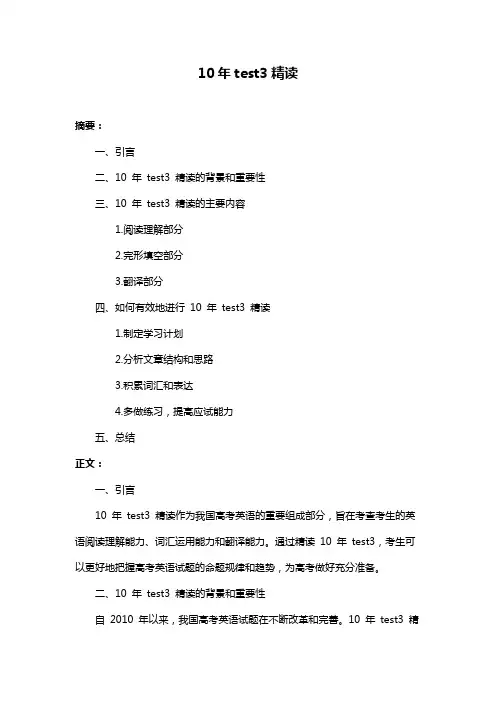
10年test3精读摘要:一、引言二、10 年test3 精读的背景和重要性三、10 年test3 精读的主要内容1.阅读理解部分2.完形填空部分3.翻译部分四、如何有效地进行10 年test3 精读1.制定学习计划2.分析文章结构和思路3.积累词汇和表达4.多做练习,提高应试能力五、总结正文:一、引言10 年test3 精读作为我国高考英语的重要组成部分,旨在考查考生的英语阅读理解能力、词汇运用能力和翻译能力。
通过精读10 年test3,考生可以更好地把握高考英语试题的命题规律和趋势,为高考做好充分准备。
二、10 年test3 精读的背景和重要性自2010 年以来,我国高考英语试题在不断改革和完善。
10 年test3 精读不仅可以帮助考生了解历年高考英语试题的命题特点,还可以通过分析真题,总结出高考英语考试的重点和难点。
因此,进行10 年test3 精读对于备考高考英语具有重要意义。
三、10 年test3 精读的主要内容10 年test3 精读主要包括阅读理解、完形填空和翻译三个部分。
1.阅读理解部分:阅读理解部分主要考查考生的英语阅读能力,要求考生在较短的时间内,快速准确地理解文章的主旨和细节。
考生在进行10 年test3 精读时,应重点关注文章的主题、作者观点、篇章结构等,以便更好地把握文章的核心内容。
2.完形填空部分:完形填空部分主要考查考生的词汇运用和语篇理解能力。
考生在进行10 年test3 精读时,应积累常用词汇和短语,掌握一定的词汇辨析技巧,同时关注文章的上下文,提高解题准确率。
3.翻译部分:翻译部分主要考查考生的英汉互译能力。
考生在进行10 年test3 精读时,应熟练掌握英语语法和句式结构,积累常用的翻译方法和技巧,提高翻译的准确性和流畅度。
四、如何有效地进行10 年test3 精读1.制定学习计划:在进行10 年test3 精读时,考生应根据自己的实际情况,制定合理的学习计划,确保每个部分都得到充分的复习和训练。

剑桥阅读解析test————————————————————————————————作者:————————————————————————————————日期:剑桥雅思10TEST2 PASSAGE1阅读解析1. 总体难度概括:中等2. 文章介绍:标题:tea and the industrial revolution话题:历史类3. 词汇准备: a段anthropological adj. 人类学的historian n. 史学工作者wrestle v. 斗争enigma n. 奥秘birth n. 诞生strike v. 罢工;打击;冲击b段puzzle n. 谜团factor n. 因素drive v. 推动,驱动affluent adj. 富足的criteria n. 标准【criterion的复数】sufficient adj. 足够的convinced adj. 确信的c段propose n. 提议cupboard n. 柜橱fuel v. 助燃,加速antiseptic adj. 防腐的,杀菌的property n. 性能tannin n. 单宁酸ingredient n. 配料hops n. 啤酒花succumb v. 屈从dysentery n. 痢疾eccentric adj. 奇怪的deduction n. 推理skepticism n. 怀疑论wary adj. 谨慎的admiration n. 羡慕strengthen v. 加强notable adj. 值得注意的distinguished adj. 杰出的favorable adj. 有利的appraisal n. 评价d段alight v. 偶然发现static adj. 静态的virus n. 病毒bacteria n. 细菌malaria n. 疟疾sanitation n. 卫生e段dig v. 探寻reveal v. 揭示antibacterial adj. 抗菌的agent n. 药剂preserve v. 保护malt n. 麦芽gin n. 杜松子酒f段grip n. 掌握,控制prevalence n. 流行coincidence n. 巧合clipper n. 帆船sip v. 啜饮g段forge v. 伪造futures n. 期货wheel n. 轮子4. 题型分析这篇文章是由二种题型组成,都是阅读考试中常见的题型。
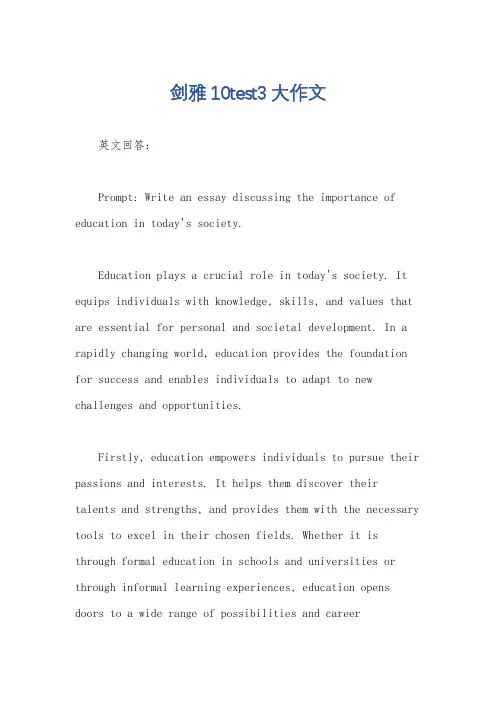
剑雅10test3大作文英文回答:Prompt: Write an essay discussing the importance of education in today's society.Education plays a crucial role in today's society. It equips individuals with knowledge, skills, and values that are essential for personal and societal development. In a rapidly changing world, education provides the foundation for success and enables individuals to adapt to new challenges and opportunities.Firstly, education empowers individuals to pursue their passions and interests. It helps them discover theirtalents and strengths, and provides them with the necessary tools to excel in their chosen fields. Whether it is through formal education in schools and universities or through informal learning experiences, education opens doors to a wide range of possibilities and careeropportunities.Furthermore, education fosters critical thinking and problem-solving skills. It teaches individuals how to analyze information, evaluate different perspectives, and make informed decisions. In an era of fake news and misinformation, the ability to think critically is more important than ever. Education equips individuals with the skills to differentiate between fact and fiction, and to question and challenge existing ideas and beliefs.Moreover, education promotes social cohesion and understanding. It exposes individuals to diverse cultures, ideas, and perspectives, fostering empathy and tolerance. Through education, individuals learn to appreciate and respect the differences among people, and to work together towards common goals. Education also plays a crucial role in promoting gender equality and empowering marginalized communities.In addition, education is a lifelong process. It does not end with graduation or the acquisition of a degree.Continuous learning and self-improvement are essential in today's rapidly changing world. Education provides individuals with the tools to adapt to new technologies, industries, and societal changes. It enables individuals to stay relevant and competitive in the job market.In conclusion, education is of paramount importance in today's society. It empowers individuals, fosters critical thinking, promotes social cohesion, and enables lifelong learning. It is through education that individuals canfulfill their potential and contribute to the betterment of society.中文回答:教育在今天的社会中扮演着至关重要的角色。
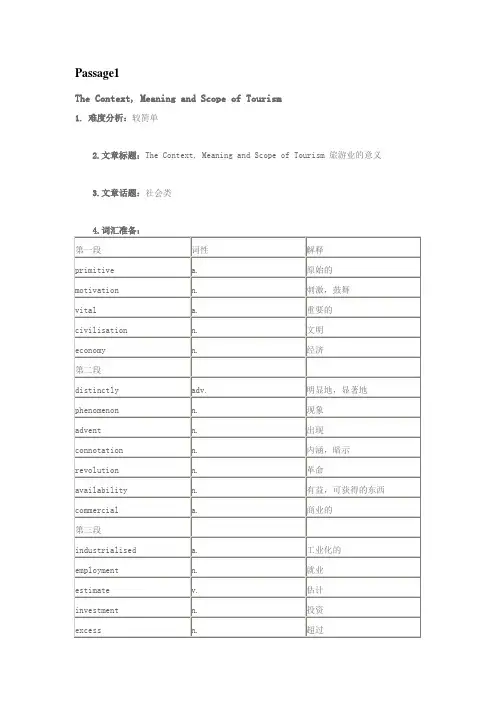
Passage1The Context, Meaning and Scope of Tourism1. 难度分析:较简单2.文章标题:The Context, Meaning and Scope of Tourism 旅游业的意义3.文章话题:社会类5. 题型分析:文章题型由三个题型组成:小标题配对题+判断题+句子填空,第一大题属于段落主旨题,后两题是细节题型。
6.题目解析:Questions 1-4 小标题配对题1. Paragraph B2. Paragraph C3. Paragraph D4. Paragraph E答案解析:1. 选ii。
定位到第二段第一句话:Tourism in the mass form as we know it today is a distinctly twentieth-century phenomenon. 表明就我们所知,广义的旅游业是一个二十世纪的现象。
选项中的mass tourism与原文中的tourism in the mass form是同义替换。
2. 选i。
定位到第三段第一句话:Tourism today has grown significantly in both economic and social importance. 即目前旅游业对经济及社会都非常重要。
选项中的significance替换原文的importance。
3. 选v。
定位到第四段第一句话:However, the major problems of the travel and tourism industry that have hidden or obscured its economic impact are the diversity and fragmentation of the industry itself. 意思是旅游业的主要问题是这个产业本身的多样性和分散性,这使得其经济影响变得不那么明显。
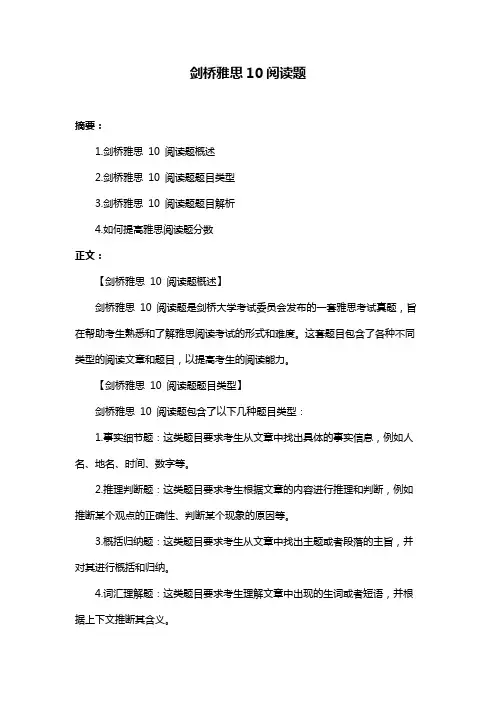
剑桥雅思10阅读题摘要:1.剑桥雅思10 阅读题概述2.剑桥雅思10 阅读题题目类型3.剑桥雅思10 阅读题题目解析4.如何提高雅思阅读题分数正文:【剑桥雅思10 阅读题概述】剑桥雅思10 阅读题是剑桥大学考试委员会发布的一套雅思考试真题,旨在帮助考生熟悉和了解雅思阅读考试的形式和难度。
这套题目包含了各种不同类型的阅读文章和题目,以提高考生的阅读能力。
【剑桥雅思10 阅读题题目类型】剑桥雅思10 阅读题包含了以下几种题目类型:1.事实细节题:这类题目要求考生从文章中找出具体的事实信息,例如人名、地名、时间、数字等。
2.推理判断题:这类题目要求考生根据文章的内容进行推理和判断,例如推断某个观点的正确性、判断某个现象的原因等。
3.概括归纳题:这类题目要求考生从文章中找出主题或者段落的主旨,并对其进行概括和归纳。
4.词汇理解题:这类题目要求考生理解文章中出现的生词或者短语,并根据上下文推断其含义。
【剑桥雅思10 阅读题题目解析】剑桥雅思10 阅读题的题目解析如下:1.事实细节题:解答这类题目时,考生需要仔细阅读文章,找出与题目相关的具体信息。
同时,考生需要注意题目中的关键词,以便快速定位答案。
2.推理判断题:解答这类题目时,考生需要根据文章的内容进行推理和判断。
考生需要注意题目中的关键词,并结合文章的内容进行分析。
3.概括归纳题:解答这类题目时,考生需要从文章中找出主题或者段落的主旨,并对其进行概括和归纳。
考生需要注意题目中的关键词,并结合文章的内容进行分析。
4.词汇理解题:解答这类题目时,考生需要理解文章中出现的生词或者短语,并根据上下文推断其含义。
考生需要注意题目中的关键词,并结合文章的内容进行分析。
【如何提高雅思阅读题分数】要想提高雅思阅读题的分数,考生需要做到以下几点:1.提高阅读速度:考生需要提高阅读速度,以便在有限的时间内完成阅读任务。
2.提高词汇量:考生需要积累足够的词汇量,以便在阅读文章时能够理解其中的生词和短语。
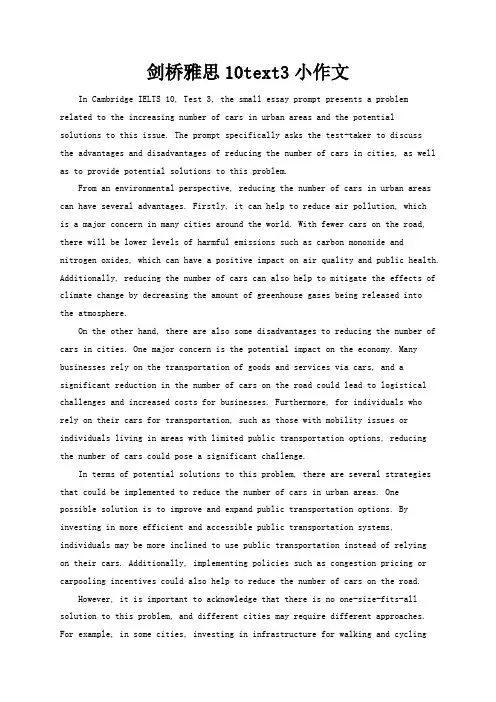
剑桥雅思10text3小作文In Cambridge IELTS 10, Test 3, the small essay prompt presents a problemrelated to the increasing number of cars in urban areas and the potentialsolutions to this issue. The prompt specifically asks the test-taker to discussthe advantages and disadvantages of reducing the number of cars in cities, as well as to provide potential solutions to this problem.From an environmental perspective, reducing the number of cars in urban areas can have several advantages. Firstly, it can help to reduce air pollution, whichis a major concern in many cities around the world. With fewer cars on the road, there will be lower levels of harmful emissions such as carbon monoxide and nitrogen oxides, which can have a positive impact on air quality and public health. Additionally, reducing the number of cars can also help to mitigate the effects of climate change by decreasing the amount of greenhouse gases being released intothe atmosphere.On the other hand, there are also some disadvantages to reducing the number of cars in cities. One major concern is the potential impact on the economy. Many businesses rely on the transportation of goods and services via cars, and a significant reduction in the number of cars on the road could lead to logistical challenges and increased costs for businesses. Furthermore, for individuals whorely on their cars for transportation, such as those with mobility issues or individuals living in areas with limited public transportation options, reducing the number of cars could pose a significant challenge.In terms of potential solutions to this problem, there are several strategies that could be implemented to reduce the number of cars in urban areas. Onepossible solution is to improve and expand public transportation options. By investing in more efficient and accessible public transportation systems, individuals may be more inclined to use public transportation instead of relyingon their cars. Additionally, implementing policies such as congestion pricing or carpooling incentives could also help to reduce the number of cars on the road.However, it is important to acknowledge that there is no one-size-fits-all solution to this problem, and different cities may require different approaches. For example, in some cities, investing in infrastructure for walking and cyclingmay be more effective, while in others, implementing stricter emissions standards for vehicles may be necessary.In conclusion, the problem of the increasing number of cars in urban areas is a complex issue that requires careful consideration of its various implications. While there are clear environmental benefits to reducing the number of cars, it is also important to consider the potential economic and social impacts of such policies. By exploring a range of potential solutions and considering the unique needs of different cities, it may be possible to develop effective strategies for addressing this problem.。
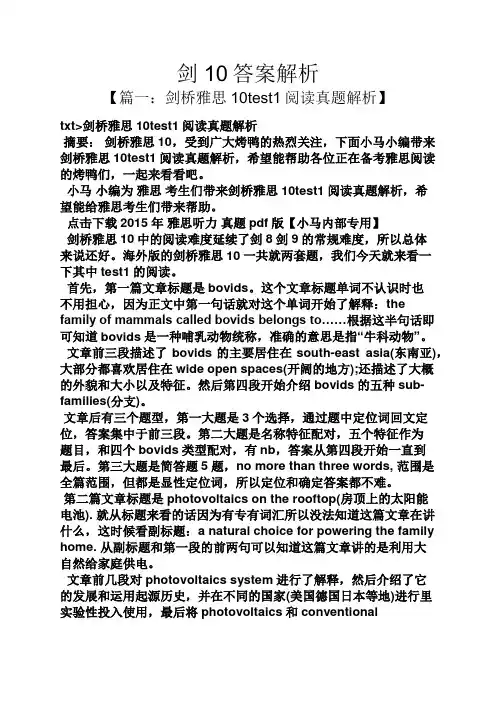
剑10答案解析【篇一:剑桥雅思10test1阅读真题解析】txt>剑桥雅思10test1阅读真题解析摘要:剑桥雅思10,受到广大烤鸭的热烈关注,下面小马小编带来剑桥雅思10test1阅读真题解析,希望能帮助各位正在备考雅思阅读的烤鸭们,一起来看看吧。
小马小编为雅思考生们带来剑桥雅思10test1阅读真题解析,希望能给雅思考生们带来帮助。
点击下载2015年雅思听力真题pdf版【小马内部专用】剑桥雅思10中的阅读难度延续了剑8剑9的常规难度,所以总体来说还好。
海外版的剑桥雅思10一共就两套题,我们今天就来看一下其中test1的阅读。
首先,第一篇文章标题是bovids。
这个文章标题单词不认识时也不用担心,因为正文中第一句话就对这个单词开始了解释:the family of mammals called bovids belongs to……根据这半句话即可知道bovids是一种哺乳动物统称,准确的意思是指“牛科动物”。
文章前三段描述了bovids的主要居住在south-east asia(东南亚),大部分都喜欢居住在wide open spaces(开阔的地方);还描述了大概的外貌和大小以及特征。
然后第四段开始介绍bovids的五种sub-families(分支)。
文章后有三个题型,第一大题是3个选择,通过题中定位词回文定位,答案集中于前三段。
第二大题是名称特征配对,五个特征作为题目,和四个bovids类型配对,有nb,答案从第四段开始一直到最后。
第三大题是简答题5题,no more than three words, 范围是全篇范围,但都是显性定位词,所以定位和确定答案都不难。
第二篇文章标题是photovoltaics on the rooftop(房顶上的太阳能电池). 就从标题来看的话因为有专有词汇所以没法知道这篇文章在讲什么,这时候看副标题:a natural choice for powering the family home. 从副标题和第一段的前两句可以知道这篇文章讲的是利用大自然给家庭供电。
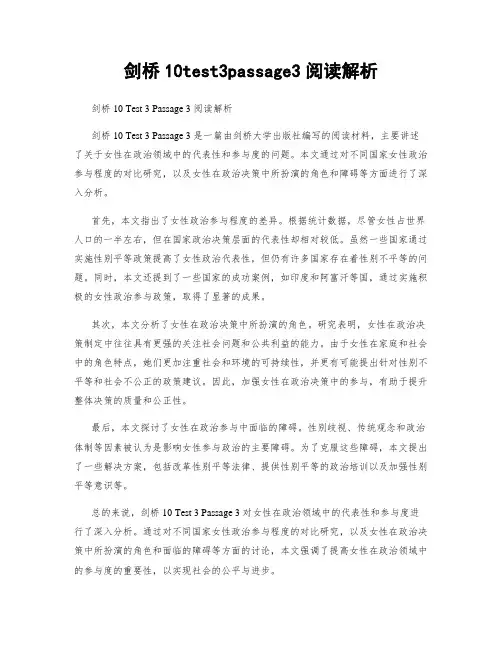
剑桥10test3passage3阅读解析剑桥10 Test 3 Passage 3 阅读解析剑桥10 Test 3 Passage 3 是一篇由剑桥大学出版社编写的阅读材料,主要讲述了关于女性在政治领域中的代表性和参与度的问题。
本文通过对不同国家女性政治参与程度的对比研究,以及女性在政治决策中所扮演的角色和障碍等方面进行了深入分析。
首先,本文指出了女性政治参与程度的差异。
根据统计数据,尽管女性占世界人口的一半左右,但在国家政治决策层面的代表性却相对较低。
虽然一些国家通过实施性别平等政策提高了女性政治代表性,但仍有许多国家存在着性别不平等的问题。
同时,本文还提到了一些国家的成功案例,如印度和阿富汗等国,通过实施积极的女性政治参与政策,取得了显著的成果。
其次,本文分析了女性在政治决策中所扮演的角色。
研究表明,女性在政治决策制定中往往具有更强的关注社会问题和公共利益的能力。
由于女性在家庭和社会中的角色特点,她们更加注重社会和环境的可持续性,并更有可能提出针对性别不平等和社会不公正的政策建议。
因此,加强女性在政治决策中的参与,有助于提升整体决策的质量和公正性。
最后,本文探讨了女性在政治参与中面临的障碍。
性别歧视、传统观念和政治体制等因素被认为是影响女性参与政治的主要障碍。
为了克服这些障碍,本文提出了一些解决方案,包括改革性别平等法律、提供性别平等的政治培训以及加强性别平等意识等。
总的来说,剑桥10 Test 3 Passage 3 对女性在政治领域中的代表性和参与度进行了深入分析。
通过对不同国家女性政治参与程度的对比研究,以及女性在政治决策中所扮演的角色和面临的障碍等方面的讨论,本文强调了提高女性在政治领域中的参与度的重要性,以实现社会的公平与进步。
剑桥雅思真题10—写作(Test 3 附高分范文)Writing Task 1You should spend about 20 minutes on this task.Write at least 150 words.参考范文1:The two bar charts given illustrate the four destinations, excluding full-time work, that the UK graduate and postgraduate students were engaged in after their graduations in 2008. Generally speaking, substantial differences could be noticed among the figures of these four categories.In terms of the UK graduates, those who devoted themselves to the further study accounted for the dominant part, with 29665 in 2008, which constituted almost one third of the total. Meanwhile, the numbers of part-time work and unemployment, 17735 and 16235 respectively, were similar, whereas the least were those doing the voluntary work, with only 3500 in this year.As for the number of postgraduate students, despite the fact that the data of further study was still the largest one, reaching 2725, the number of students obtaining the part-time occupations was only approximately 200 smaller than that of further study, namely, 2535 in 2008. Similarly, compared with those of UK graduates, the number of postgraduate students who were in the condition of unemployment and being volunteers were also the least (1625 and 345 respectively).To summarise, the majority of the graduate students chose to continue their study, while dominant postgraduate students preferred part-time work as well as further study.参考范文2:The bar charts indicate what UK graduate and postgraduate students did apart from full-time job in 2008.According to the first graph, most graduates decided to study continually, the amount of that represented 29665. Meanwhile, 17735 undergraduates chose to do part-time work, which is over five times as much as that of voluntary job. Surprisingly, the figure for graduate students who remained unemployed was relative high, more than half of that of further study.The second graph shows the choices of postgraduate students when confronted with the same situation. Although the amount of postgraduate students is ten times less than that of undergraduates in total, the tendency seemed to be alike. The figure for further study ranked the first position, at 2725. However, the difference between the part-time work and the further study narrowed when compared with that happened on graduate students. The number of postgraduates doing voluntary work was the least, represented 345, among the four choices.Overall, the postgraduate and graduate students seemed to have the similar trend on deciding what to do excluding full-time work after leaving college in 2008.参考范文3:The two charts show where students went after completing undergraduate and postgraduate degrees respectively.From the first chart, we see that the number of graduate students who chose not to enter full-time work in 2008 was, in total, around 67, 000. Of those, the highest proportion chose to further their studies with a postgraduate program at 29, 665 students. Secondly, the number of students who went into a part- time job is close to the number of students who failed entirely to find one, at 17, 735 and 16, 235 respectively. Finally, 3, 500 students chose to enter voluntary work. The second chart shows the destination of postgraduate students. We can see that while the overall number of students is obviously lower, the proportion of students’ life choices is roughly similar. Hence, the majority of postgraduates went on to study more, with 2, 725 people choosing this option. There is a slight divergence with part- time work (2, 535) being higher than unemployment (1, 625) but the general trend remains. Finally, as with graduates, a small minority (345) chose to pursue voluntary work.Writing Task 2You should spend about 40 minutes on this task.Write about the following topic:Give reasons for your answer and include any relevant examples from your own knowledge or experience.Write at least 250 words.参考范文:It is said that countries are becoming similar to each other because of the global spread of the same products, which are now available for purchase almost anywhere. I strongly believe that this modern development is largely detrimental to culture and traditions worldwide.A country's history, language and ethos are all inextricably bound up in its manufactured artefacts. If the relentless advance of international brands into every corner of the world continues, these bland packages might one day completely oust the traditional objects of a nation, which would be a loss of richness and diversity in the world, as well as the sad disappearance of the manifestations of a place`s character. What would a Japanese tea ceremony be without its specially crafted teapot, or a Fijian kava ritual without its bowl made from a certain type of tree bark?Let us not forget either that traditional products, whether these be medicines, cosmetics, toys, clothes, utensils or food, provide employment for local people. The spread of multinational products can often bring in its wake a loss of jobs. as people turn to buying the new brand, perhaps thinking it more glamorous than the one they are used to. This eventually puts old-school craftspeople out of work.Finally, tourism numbers may also be affected, as travellers become disillusioned with finding every place just the same as the one they visited previously. To see the same products in shops the world over is boring, and does not impel visitors to open their wallets in the same way that trinkets or souvenirs unique to the particular area do.Some may argue that all people are entitled to have access to the same products, but I say that local objects suit local conditions best, and that faceless uniformity worldwide is an unwelcome and dreary prospect.。
雅思10答案解析剑桥雅思10Test3阅读Passage1答案解析 The Context, Meaning and Scope of Tourism 旅游业剑桥雅思10阅读第三套题目第一篇文章的13道题由4道段落标题匹配,6道TRUE/FALSE/NOT GIVEN判断,以及3道单句填空构成,难度不算太短。
下面是具体每道题目的答案解析。
点击查看这篇雅思阅读中需要大家掌握的重点词汇与对应的原文翻译:雅思真题阅读词汇剑桥雅思10 test 3 passage 1 旅游业剑桥雅思10Test3阅读Passage1原文翻译 The Context, Meaning and Scope of Tourism 旅游业雅思10答案解析 1第1题答案:ii对应原文:B段:Tourism in the mass form as we know it today is a distinctly twentieth-century phenomenon答案解析:B段一开始就说了我们所熟悉的大众旅游业是20世纪才有的现象。
随后按照时间顺序介绍了其起源,二战后的发展,以及发挥的作用。
由此确定ii为答案。
第2题答案:i对应原文:C段:Tourism today has grown significantly in both economic and social importance … Thus, tourism has a profound impact both on the worldeconomy and, because of the educative effect of travel and the effects on employment, on society itself.答案解析:C段开头和结尾都提到了旅游业对经济和社会的重要性,很容易确定i为答案。
第3题答案:v对应原文:D段:the major problems of the travel and tourism industry that have hidden, or obscured, its economic impact are the diversity and fragmentation of the industry itself.答案解析:D段开始提到旅游业自身的多样性文章来自老烤鸭雅思和分散性掩盖或模糊了其经济影响。
剑桥雅思10阅读解析Test1Passage1体裁说明文主题牛科动物结构第一段:牛科概述第二段:分布和体型第三段:共同特征第四段:五种亚科牛亚科第五段:羚羊亚科第六段:羊亚科第七段:鹿羚亚科第八段:叉角羚剑桥雅思10阅读解析试题解析剑桥雅思10阅读解析Test1Passage1 Question 1-3题型:multiple choice题型解析:本题属单选题,注意题目说明:在ABCD中选择正确的。
剑桥雅思10阅读解析Test1Passage1 Question 4-8题型:matching题型解析:搭配题,根据选项定位关键词,题干是对应原文的同义改写剑桥雅思10阅读解析Test1Passage1 Question 9-13题型:选词填空题型解析:根据题干关键词进行定位,用原文中不超过三个词来回答问题。
剑桥雅思10阅读解析Test1Passage2难度分析:中等文章标题:European Transport Systems 1990-2010 欧洲的交通系统文章话题:交通运输类词汇准备:第一段词性解释conceive v. 设想vigorous a. 精力充沛的;强健的facilitate v. 促进,使便利substantial a. 大量的fleet n. 车队第二段internal a. 部的frontier n. 边界abolish v. 废除emphasis v. 强调assembly n. 集会;会议第三段candidate n. 候选人haulage n. 货运费inherit v. 继承第四段imperative n. 重要紧急的事integrate v. 合并ambitious a. 有雄心的propose v. 提议nonetheless adv. 尽管如此第五段emission n. 排放estimate v. 评估reverse v. 颠倒,转变culprit n. 肇事者;罪犯第六段shift v. 转移;转型deteriorate v. 退化;恶化emerge v. 出现第七段solely adv. 单独complementary a. 互补的curb v. 控制;限定revitalize v. 使强壮;使恢复生机第八段infrastructure n. 基础设施guarantee v. 保证saturate v. 使饱和artery n. 干线;动脉题型分析:文章题型由两个题型组成:小标题配对+判断题,一个主旨题型一个细节题型。
独家解析剑桥雅思10Test1Passage3阅读真题独家解析剑桥雅思10Test1Passage3阅读真题剑桥雅思10Test1Passage3阅读真题,无疑是烤鸭们大大的福利,不要吝啬你的眼睛哟,进来看看,不然你丢的不是前程百利而是雅思高分。
READING PASSAGE 3you shouldspend about 20 minutes on Questions 27-40,which are based on Reading Passage 3 below.Reading Passage 3 has four sections (A-D). Choose the mostsuitable heading for each section from the list of headings below.Write the appropriate numbers (Ⅰ-Ⅶ) in boxes 27-30 on your Answer Sheet There aremore headings than sections, so you will not use all of them.List ofHeadings1. Top Ocean Predators2. Toxic Exposure3. Declining FishPopulations4. Pleasure Boating in the San JuanIslands5. UnderwaterNoise6. Smog in Large Cities7. Impact of Boat Traffic27 Section A28 Section B29 Section C30 Section DIssues Affecting the SouthernResident OrcasAOrcas,also known as biller whales, are opportunistic feeders,which means they will take a variety of different preyspecies. J, K, and L pods (specific groups of orcas found in the region) arealmost exclusively fish eaters. Some studies show that up to 90 percent oftheir diet is salmon, with Chinook? salmon being far and away their favorite.During the last 50 years, hundreds of wild runs of salmon have become extinctdue to habitat loss and overfishing of wild stocks. Many of the extinct salmonstocks are the winter runs of chinook and coho. Although the surviving stockshave probably been sufficient to sustain the resident pods, many of the runsthat have been lost were undoubtedly traditional resources favored by the residentorcas. This may be affecting the whales’ nutrition in the winter and mayrequire them to change their patterns of movement in order to search for food.Other studies with tagged whales haveshown that they regularly dive up to 800 feet in this area.Researcherstend to think that during these deep dives the whales may be feeding on bottomfish.Bottomfish species in this area would include halibut, rockfish, lingcod, andgreenling. Sci entists estimate that today’s lingcod population in northernPuget Sound and the Strait of Georgia is only 2 percent of what it was in 1950.The average size of rockfish in the recreational catch has also declined byseveral inches since the 1970s, which is indicative of overfishing. In somelocations, certain rockfish species have disappeared entirely. So even ifbottomfish are not a major food resource for the whales, the present lownumbers of available fish increases the pressure on orcas and all marineanimals to find food. (For more information on bottomfish see the San JuanCounty Bottomfish Recovery Program.)....剑10Test1Passage3全文及阅读解析:/doc/6e6537082.html,/thread-47316-1-1.html以上就是剑桥雅思10Test1Passage3阅读真题解析的内容介绍,这里我们只是为大家展示了一个入口,想要下载全部解析,不妨点击上面链接直接进入前程百利雅思论坛专区。
These two bar charts show destinations where 2008 uk graduates and postgraduates who did not engage in full-time job went1,000,000,000According to the first graph, there were 29,665 students who enrolled in further education, which held the highest figure in these four kinds of choices. The voluntary work, in the first graph, was the least favourable choice among graduate students, which is smallest number. The number for part-time work and umemployment were 17,735 and 16,235 respectively.As can be seen from the second chart, the overwhelming number of postgraduates pursued for further education program is 3,725, the biggest number among four destinations. Followed by part-time work (2,535) and unemployment (1,625). Finally, 345 postgraduates devoted themselves to work as volunteers.for there were 2725 postgraduate students chose to do in that year. And voluntary jobs was also the least popular jobs in these four kinds that was chosen by only 345 students. Thenumber of choosing part-time work was nearly as much as the first one, which figure was 2535. What about the unemployment jobs? It was chosen by 1625 students in 2008.We can see that in that year, student continued to study rather than working, and when they chose to work, voluntary work was that big parts of them who did not attend to do.We can see that in that year, four major categories with varing degree are listed in both charts. Also noticeable is the fact that the figures for graduates are appoximately ten times higher than that of postgraduates in each category.。
Passage1The Context, Meaning and Scope of Tourism1. 难度分析:较简单2.文章标题:The Context, Meaning and Scope of Tourism 旅游业的意义3.文章话题:社会类5. 题型分析:文章题型由三个题型组成:小标题配对题+判断题+句子填空,第一大题属于段落主旨题,后两题是细节题型。
6.题目解析:Questions 1-4 小标题配对题1. Paragraph B2. Paragraph C3. Paragraph D4. Paragraph E答案解析:1. 选ii。
定位到第二段第一句话:Tourism in the mass form as we know it today is a distinctly twentieth-century phenomenon. 表明就我们所知,广义的旅游业是一个二十世纪的现象。
选项中的mass tourism与原文中的tourism in the mass form是同义替换。
2. 选i。
定位到第三段第一句话:Tourism today has grown significantly in both economic and social importance. 即目前旅游业对经济及社会都非常重要。
选项中的significance替换原文的importance。
3. 选v。
定位到第四段第一句话:However, the major problems of the travel and tourism industry that have hidden or obscured its economic impact are the diversity and fragmentation of the industry itself. 意思是旅游业的主要问题是这个产业本身的多样性和分散性,这使得其经济影响变得不那么明显。
选项中的difficulty,effects分别替换原文的problems和impact。
4. 选vii。
定位到第五段第一句话:Once the exclusive province of the wealthy, travel and tourism have become an institutionalised way of life for most of the population. 表明旅游业曾经是富人们的特权,而现在已经变成大多数人们习以为常的一种生活方式了。
选项中的world,impact替换原文的most of the population, institutionalised。
Questions 5-10 判断题5. The largest employment figures in the world are found in the travel and tourism industry.6. Tourism contributes over six per cent of the Australian gross national product.7. Tourism has a social impact because it promotes recreation.8. Two main features of the travel and tourism industry make its economic significance difficult to ascertain.9. Visitor spending is always greater than the spending of residents in tourist areas.10. It is easy to show statistically how tourism affects individual economies.答案解析:5. 选TRUE。
定位到第三段第三句话: According to the World Travel and Tourism Council (1992), ‘Travel and tourism is the largest industry in the world on virtually any economic measure including value-added capital investment, employment and taxcontributions’。
意思是旅游业是全世界最大的行业,不管是用哪种经济学估算,其中包括资本增值投资,就业及税收贡献。
题目中的figures替换原文measure。
6. 原文没有提到Australian gross national product这个概念,所以选择NG。
7. 原文没有提到recreation这个概念,所以选择NG。
8. 选TRUE。
定位到第四段第一句话:However, the major problems of the travel and tourism industry that have hidden, or obscured its economic impact, are the diversity and fragmentation of the industry itself. 意思是旅游业的主要问题是这个产业本身的多样性和分散性,这使得其经济影响变得不那么明显。
题目中的two main features指代原文的diversity and fragmentation。
9. 原文没有提到visitor spending 和residents’ spending的比较关系,所以选择NG。
10. 选FALSE。
定位到第四段倒数第二句,原文表明this problem has made it difficult ...to estimate the contribution it makes, 即估算旅游业对经济的贡献很困难,所以选FALSE。
Questions 11-13 句子填空题11. In Greece, tourism is the most important ________.12. The travel and tourism industry in Jamaica is the major ______ .13. The problems associated with measuring international tourism are often reflected in the measurement of _______ .答案解析:11. 填source of income/home。
定位到最后一段的第三句: For example, tourism is the major source of income in Bermuda, Greece, Italy, Spain, Switzerland, and most Caribbean countries. 说明旅游业在以下国家都是收入的主要来源,题目中的most important替换原文的major。
12. 填employer。
定位到最后一段的第四句: In addition, Hawkins and Ritchie, quoting from data published by the American Express Company, suggesting that the travel and tourism industry is the number one ranked employer in the Bahamas, Brazil, Canada, France, (the former) West Germany, Hong Kong, Italy, Jamaica, Japan, Singapore. 说明旅游业在一下国家是最需要聘用雇员的行业,题目中的major替换原文的number one ranked。
13. 填domestic industry。
定位到最后一段的最后一句: In many cases, similar difficulties arise when attempts are made to measure domestic tourism. 说明测量估算国内旅游业非常困难,题目中的measurement, problems替换原文的measure, difficulties。
Passage 2Autumn leaves1. 难度分析:难2. 文章标题:Autumn leaves 秋天的叶子3. 文章话题:生物类4. 词汇准备:5. 题型分析:文章题型由三个题型组成:单项选择题+句子配对题+判断题,都是细节题型。
6. 题目解析:Questions 14-18 段落信息配对题14. a description of the substance responsible for the red colouration of leaves 题解:题目的意思是一种对叶子产生红色的物质的描述,定位在C段首句:the source of the red is widely known: it is created by anthocyanin,所以答案选择C。
15. the reason why trees drop their leaves in autumn题解:题干定位drop leaves in autumn在B段第六行:the tree saves its precious resources and discards them 树节省了资源并且把他们丢弃,所以选择B。
16. some evidence to confirm a theory about the purpose of the red leaves题解:题目的意思是证明红叶目的的理论证据,出现在H段第二行:there are clues out there.所以选择H。
17. an explanation of the function of chlorophyll题解:题目的意思是对叶绿素功能的解释,定位在B段第一行:the molecule that captures sunlight and converts that energy into new building materials for the tree,的意思是一种分子用来捕捉阳光并转变成树木成长所需的能量。